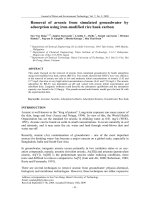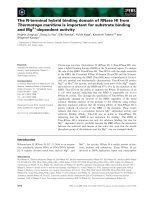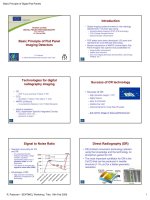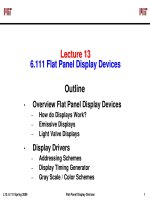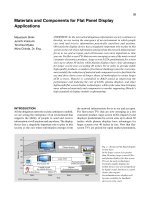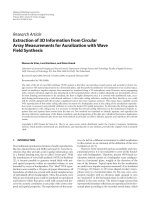extraction of liquid crystals from flat panel display devices using both liquid and supercritical carbon dioxide
Bạn đang xem bản rút gọn của tài liệu. Xem và tải ngay bản đầy đủ của tài liệu tại đây (500.98 KB, 6 trang )
EXTRACTION OF LIQUID CRYSTALS FROM FLAT PANEL DISPLAY DEVICES
USING BOTH LIQUID AND SUPERCRITICAL CARBON DIOXIDE
A.J. Hunt
*
, J.H. Clark, S.W. Breeden, A. S. Matharu, C. Ellis, J. W. Goodby, J.A. Bottomley, S. J. Cowling
Green Chemistry Centre of Excellence, Department of Chemistry, University of York, Heslington, York,
YO10 5DD, UK,
, Fax : (+44) (0)1904 432705
Recent legislation such as the WEEE directive in Europe [1] has meant that devices such as
flat panel displays can no longer be disposed of by landfill. Current methods for disposal
and/or recycling of these valuable waste resources are at best limited. It is predicted that by
2010 in the UK alone, 33 tonnes of liquid crystal flat panel displays will be discarded daily,
equating to 9 tonnes of liquid crystal per year with a potential value of tens of millions of
dollars.[2] Herein we demonstrate that both liquid and supercritical carbon dioxide are
effective and environmentally benign solvents for extraction of liquid crystals from display
devices. Typically the recovery with liquid carbon dioxide was in excess of 96% after 15
minutes. Extractions with carbon dioxide demonstrate numerous advantages over traditional
solvents such as dichloromethane; toxicity is reduced, no solvent residues remain after release
of pressure and in many cases secondary purification processes are not required. Pilot scale
extractions have been undertaken and demonstrated high extraction yields consistent with
those achieved on a laboratory scale. Variation of both temperature and pressure (and
therefore density) has shown that a degree of fractionation is achievable at the point of
extraction and/or collection. The recovered liquid crystal exhibits the nematic phase as
evidenced by thermal polarising optical microscopy (Figure 1).
Figure 1: Transition from nematic to isotropic state of extracted liquid crystal mixture.
INTRODUCTION
The influence of Liquid Crystal Displays (LCDs) on modern society has been dramatic.
LCDs are now almost ubiquitous in electronic goods ranging from control instruments (e.g.
thermostat controllers) to PC monitors and increasingly in large area high definition display
devices. Although liquid crystals are non toxic,[3] they do persist in the environment and with
increasing concern for our fragile environment, legislative measures have been taken to
reduce the amount of electronic waste sent to landfill. The WEEE Directive 2002/96/EC of
the European Parliament and of the Council on Waste Electrical and Electronic Equipment
came into operation on the 2
nd
January 2007 (within the UK) and requires the disassembly of
all LCDs with an area over 100 cm
2
.[1] It is predicted that over ten thousand metric tonnes of
LCD will be available for recycling in 2010 in the UK alone (Table 1). This equates to a
potential recovery of 9 tonnes of liquid crystals with a market value of between 27 and 187
million dollars dependent on liquid crystal quality; 900 kg of indium and 8,000 tonnes of
optical quality glass can also be recovered.[2] Incineration is wasteful, harmful to the
environment and costly. It is estimated that 2.5 billion LCDs are approaching their end of life
and conservative predictions on the growth in sales of LCDs are 16-28% every five years,
therefore need for liquid crystal recovery or recycling of LCDs is imperative.[4]
Table 1: Predictions for LCD television recovery in the UK until 2010 [2]
Y
ear 2004 2005 2006 2007 2008 2009 2010 Total
Units (1000)
39 39 74 109 134 305 770
1,470
Mass (MT)
1,050 1,050 1,650 2,250 3,125 5,500 10,900
25,525
Avg Unit Mass kg/Unit
27 27 22 21 23 18 14
Predicted Disposal Statistics for LCD Televisions in the UK
Although, extraction of liquid crystals with volatile organic solvents such as dichloromethane
offers a short term solution, these highly toxic and potentially carcinogenic solvents are not
viewed as a “sustainable” long term solution to the problem. In recent years supercritical
carbon dioxide (ScCO
2
) has proven to be an excellent environmentally benign solvent for
extraction of many organic compounds.[5] Work by Aguiar-Ricardo et al. investigated the
solubility of E7 (a multi component commercially available liquid crystal mixture) in ScCO
2
,
for the purpose of developing polymer dispersed liquid crystal devices.[6,7] Their work
demonstrated the potential to fractionate commercially available liquid crystal mixtures.
Following from this the first carbon dioxide extractions of defunct LCDs was demonstrated at
the University of York, resulting in a worldwide patent application for this process.[8] Herein
we demonstrate that ScCO
2
is an excellent benign solvent for extraction of liquid crystals
from defunct display devices with high efficiency.
MATERIALS AND METHODS
A LCD (Figure 2A) device may be disassembled by removal of screws securing the back
panel to the device. As can be seen in figure 2B the panel is attached to control units via
wires and can easily be removed. The driving circuitry is held in place by screws, once
removed, it is possible to dismantle the display panel (Figure 2C). The glass substrate is held
in place by brackets which are attached to the light fittings, after unscrewing the retaining
screws, it is a simple matter to remove the glass (Figure 2D).
Figure 2: Demonstration of the disassembly of a defunct LCD
Carbon dioxide extraction was carried out using a Thar Technologies SFE-500F-2-FMC
System and liquid withdrawal carbon dioxide (99.9 %). The extraction vessel was charged
with 300 g of glass from a LCD panel (Figure 2D) cut into 10 cm x 4 cm segments. Typical
extraction took place at a pressure of 250 bar and 40°C with a flow rate of 40 g/min, the
collector was maintained at atmospheric pressure at 40°C. Extraction durations of 30 minutes
were typical after which the extractor was depressurised, the glass removed and the liquid
crystals were recovered and retained for analysis. Following extraction the glass was
extracted with DCM to enable the calculation of the percentage recovery.
RESULTS
Initial extractions where conducted on small LCDs designed to control thermostats (figure
3A). Using supercritical conditions of 250 bar and 40ºC the extraction recovery from
complete screens was poor, 0.1% of the total liquid crystal present. The removal of a resin
seal from the outer edge of the LCD did not significantly increase the recovery (0.15%). An
investigation of sample preparation comparing clipping the screens to expose one edge for
extraction, halved screens and smashed screens (Figure 3B) was therefore undertaken. All
three processing methods led to substantial increases in liquid crystal recovery. Smashing of
screens was demonstrated to be a quick and effective processing method, which exhibited
quantitative recovery of liquid crystals (yields of 0.2% yield based on the mass of the panel).
This result is significant as it matches the best recovery obtained from traditional solvents
such as DCM. Recovery from halved screens was lower than that of the smashed screens
(85%), although was still significantly higher than clipped screens from which it was possible
to extract 36%.
A
B
Figure 3: Picture of A) small LCD display and B) Processing methods for extraction
Although the screens appeared to be identical and from the same batch, they were in fact
different and on analysis it became clear that numerous components were present. A screen
typically contains between 8 and 16 different chemical entities (Figure 4). This example
(Figure 4) demonstrates one of the problems associated with recovery of liquid crystals from
defunct devices; typically there is little information on the screen and as such is frequently not
possible to ascertain the switching mode of the device let alone the components. This can
lead to extracts with two or more switching types within the same mixture and therefore
resulting in an inferior extract and possibly a non liquid crystal material. We are conducting
further work to develop a simple means for determination of switching mode.
A
B
C
Figure 4: Three chromatograms depicting A) single screen extract, B) single screen extract,
C) extract of multiple smashed screens
Pilot scale extractions have been undertaken and demonstrated high extraction yields
consistent with those achieved on a laboratory scale. On a commercial scale extraction costs
can be reduced dramatically by use of liquid carbon dioxide; as a result extractions were
attempted at 60 bar and 20ºC. These conditions were found to be as effective as supercritical
extractions and extraction yields in excess of 96 % in 15 minutes were obtained.
Extractions of larger defunct display devices (Figure 2) has also been attempted and was
found to be successful at 250 bar and 40ºC and gave high recoveries (96%). Analysis of the
liquid crystal mixture by GC-MS indicated the presence of multiple components as did
19
F
NMR, which confirmed the presence of multiple fluorinated environments within these
molecules (Figure 5).
Figure 5:
19
F NMR spectrum of the liquid crystal extract
A potential structure of one such component is represented in figure 6. Isolation of individual
components was conducted by preparative HPLC and subsequent analysis by
1
H and
13
C
NMR, amongst others, confirmed the structure to be that shown in figure 6. Identification of
the remaining components in the mixture could lead to the development of a library.
Fractionation of these molecules has been attempted with limited success; the high solubility
of these molecules in carbon dioxide and the fact that these molecules may only differ by the
length of aliphatic groups makes this process difficult. Incorporation of modifiers such as
ethanol is one possible method for decreasing the solubility of liquid crystal thus promoting
fractionation. Although further work is needed to fully explore this area, work conducted thus
far has demonstrated that liquid crystals can be fractionated at collection through use of
fractional separators or at the point of extraction by stepwise alterations of pressure and
temperature.
Figure 6: A) Structure of isolated component, B)
1
H NMR spectrum of isolated component
(A) and C)
13
C NMR spectrum of isolated component (A)
CONCLUSION
Liquid crystal mixtures of high value can easily be extracted with liquid carbon dioxide
within 15 minutes. At present, fractionation of liquid crystal mixtures is limited due to the
very high solubility of these materials, although work to address these problems is ongoing.
REFERENCES:
[1] Union, T.E.P.a.t.C.o.t.E., WEEE - Directive 2002/96/EC of the European Parliament and
of the Council. 2007
[2] www.mtprog.com, British Government, DTI Market Transformations programme website
[3] Becker W., Simon Hettich B., Hönicke P., Toxicological and Ecotoxicological
Investigations of Liquid Crystals and Disposal of LCDs. Merck, 2003
[4] Martin R., Simon Hettich B., Becker W., Safe recovery of liquid crystal displays (LCDs)
in compliance with WEEE, Electronics goes green 2004+, Berlin, 2004
[5] Hunt A.J., The Extraction of High Value Chemicals from Heather (Calluna Vulgaris),PhD.
Thesis, University of York, 2006
[6] Brás A.R.E., Casimiro T., Caldeira, J., Aguiar-Ricardo A., Solubility of the Nematic
Liquid Crystal E7 in Supercritical Carbon Dioxide. J. Chem. Eng., 50, 2005, p. 1857-1860.
[7] Brás A.R.E., Henriques S., Casimiro T., Aguiar-Ricardo A., Sotomayor J., Caldira J.,
Santos C., Dionisio M., Characterization of a Nematic Mixture by Reversed-Phase HPLC and
UV Spectroscopy. Liquid Crystals, 34(5), 2007, p. 591–597
[8] Breeden S. W., Clark J. H., Cowling S. J., Goodby J. W., Matharu A. S., World Patent
Application, WO2007099352, 2007
